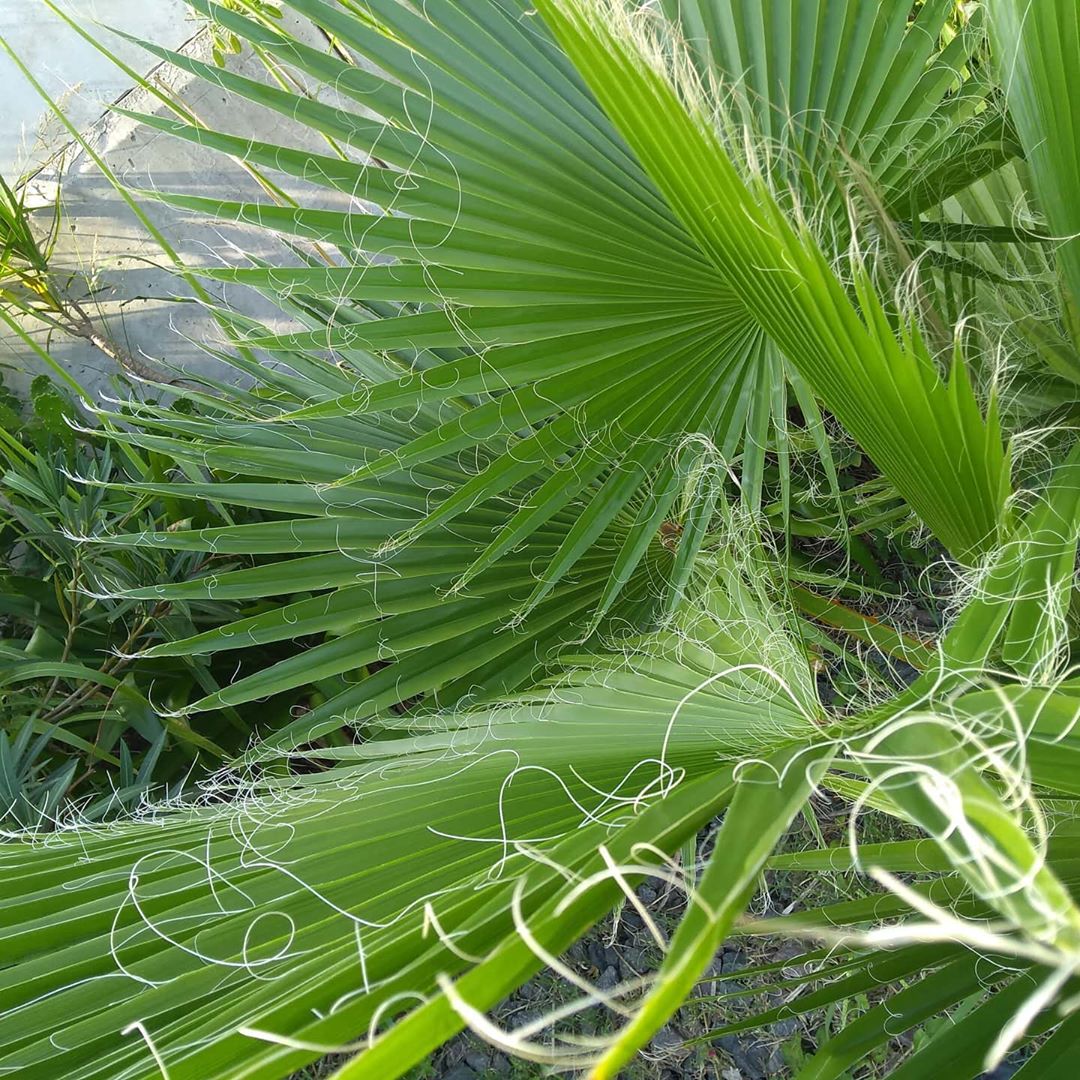Increasingly found in the halls of various buildings and offices in palm tree charm with split two-thirds the length of the sheets in the form of a fan, placed on top. This is one of numerous overseas guests, and widely spread in recent years in temperate climates, palm "washingtonia Robusta".
Her presentation to the world occurred in 1932 when on the eve of the Summer Olympic games this kind of decorated Los Angeles – the city where they were held. Since then, she began to spread across the planet, and today this Mexican native can be seen not only in natural conditions on different continents (particularly in the middle East, southern Europe and North Africa), but also as a decorative houseplant.
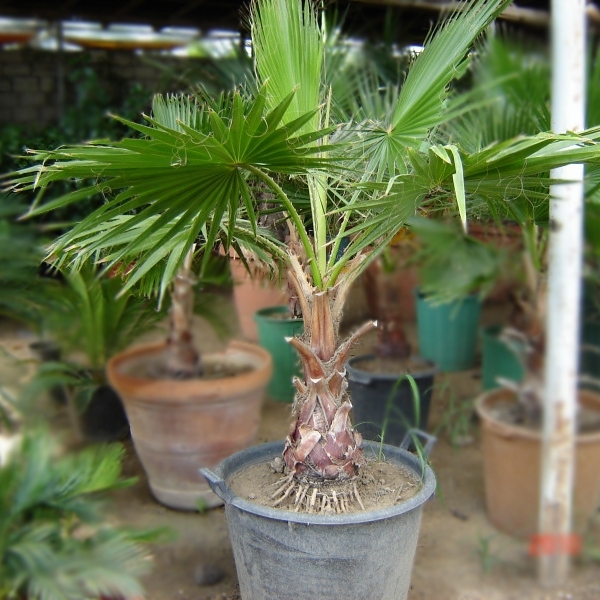
Washingtonia Robusta
A little bit of washingtonia
Washingtonia Robusta (aka – washingtonia powerful, sturdy, Sonora and the Mexican fan palm) is a perennial tree, one of the two species of washingtonia palms, which is characterized by:
- bright green leaves with sharp spines on brownish stalks.
- compact crown.
- irregular (once in several years) bloom that forms numerous flowers in orange, pink and white shade, able to reach up to 3 meters in length.
- the spherical fruit is a drupe blue-black or brown with a diameter of 8 mm to 1 cm, appearing after flowering. The fruit is nutritious, so it is very fond of birds. There is evidence that even its flesh is eaten in its natural habitat vashingtonii Robusta.
- dense sheath of old leaves that do not fall off when drying, making washingtonia informally referred to as "tree in a child's skirt".
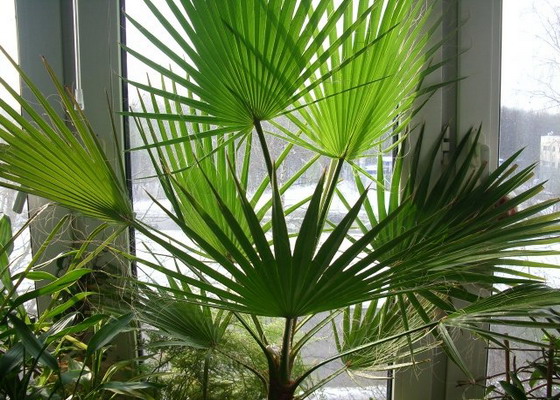
Palma characterized by the rapid growth in the natural environment can grow up to 30 meters, so if you've started to grow in a regular room, albeit with a high ceiling, it reaches its age of 5-6 years may be required "move" to another room. While the young tree leaves can reach a length of 120 cm, and the barrel after the final formation of up to 45 cm Experts recommend the growth to expand the palm relative to the light source to the leaves covered it evenly. Ideal for growing Robusta washingtonia at home – spacious verandah, balcony, Conservatory or winter garden. One of the most popular varieties suitable for growing in the apartment or house – washingtonia in Santa Barbara. More often it occurs in the premises as a landscaping, as it is able to carry even a medium air pollution.
Features care and maintenance
Experienced gardeners know that the palm tree the washingtonia Robusta is famous for demanding a special approach and even some moodiness when grown at home. For example, some particular care that should know the owners of this unusual plant.
- the presence of full sunlight, whose rays are directed from the West or South side. Valid some shade, however, one must keep in mind that it will restrain the growth and development of washingtonia. In addition, a tangible lack of light will affect the shape of the leaves: they become more elongated, and rather weak.
- a constant flow of fresh air, especially in winter. Heating and dry air palm tolerates bad, and when excessive dryness the tips of the leaves start to darken.
- good fertile soil for indoor plants is able to absorb and retain moisture. If such soil cannot be acquired, it is possible to prepare yourself by taking a garden soil, peat and coarse sand or perlite in the ratio 1:2:1. Sometimes to this mixture to prevent drying out in critical situations (for example, if you need to go somewhere on a long trip and no one to ask, to care for a palm tree) add vermiculite. In the tank with palm tree should always be the hole.
- the temperature in the room with washingtonia should always be within +10-24 degrees high (55-75%) humidity levels. Some experts advise to spray the leaves of Robusta every seven days warm water from a spray bottle.
- water the palm tree should be as drying of the soil and only warm bottled water with a temperature of 20-25 degrees, so as not to cause hypothermia root system. The regularity and extent of irrigation depends on the time of year: summer – 1 time in 5-7 days, abundant; in winter, less and moderate. If watering is insufficient, the tips of the leaves fade and turn yellow. You can also observe paleness and yellowness of the tip with a sufficient level of watering is a sign that the indoor humidity is insufficient. For its increase it is possible to put a container of washingtonia Robusta on a tray of pebbles and water. Sometimes you can find the recommendation to use a watering pooled rainwater, but a number of experts do not advise to do it, citing his warning that modern rain too many acids can adversely affect the health of the trees.
- during the growth of the palm washingtonia needs regular fertilizing complex fertilizers, which is necessary to make the soil once a month when watering. In addition to it, you must use organic fertilizers and chelated. Acceptable use once a year in early spring granular fertilizer for palms or universal liquid feeding from specialized shops. In winter washingtonia feed phosphorus-potassium fertilizers that help her survive the cold season.
- leaves vashingtonii care needs. From time to time they must be cleaned with a damp cloth or sponge and trim the dry ends as they appear. Small plants it is possible to arrange a warm shower, watching the water pressure: it needs to be so that the leaves and stems are not bent from a water stream. If this happens, the previous form they buy can not. The lower leaves, the "baby skirt" – when grown in the home should be carefully removed with a sharp knife, taking care not to damage the barrel.
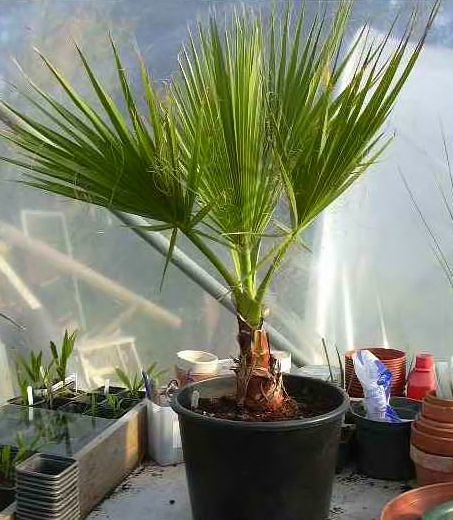
Transplanted washingtonia depending on her age:
- plants up to 3 years – annually;
- from 3 to 5 years – 1 every 2-3 years.
- 5 to 10 years old, growing in tubs, – once in 5 years.
Plants older than 10 years, the transplant replaces the shift of the top layer of the substrate with a thickness of 3cm. of fresh.
Transplant a palm tree by the usual perevarivaya in a new high pot (low and wide container for the her), trying not to disturb the root ball, in a prepared soil composed of humus, sod and leaf soil and sand in the ratio 2:2:2:1. You can use ready shop zemlesmes "For palm", "For dracaena and Yucca". After transplantation vashingtonii Robusta provide a warmer, higher by two or three degrees than normal temperature, the contents and cover from direct sunlight for 2-3 weeks until the plant adapts.
To grow a palm tree the washingtonia Robusta is possible exclusively by means of seeds, but it is quite a lengthy process, during which you must:
- place the seeds at some time in the warm water.
- then plant them in clean containers with a maximum depth of 15 cm with loose sterilized substrate consisting of leaf humus, sand (or perlite) and peat in the ratio 2:1:1, deepening the seeds about 1 cm.
- to place crops on the heating, so that the temperature was around 28 degrees, under indirect sunlight or fluorescent light. The soil during germination should be heated to 25-30 degrees Celsius.
- to prevent moisture evaporation is to cover the capacity of the plant with a film, glass or non-woven covering material such as spandex.
If done correctly, after two weeks you can observe the appearance of the first shoots. When they are a little sprout them carefully, trying not to damage the roots and cotyledons, transplanted into individual pots with a diameter not exceeding 7 cm with soil for Mature plants. If in the future it is planned cultivation of Robusta out of the room, periodically it should be put in the garden to accustom to the external environment. In the summer it is recommended to leave outdoors – it thrives in our climate zone, however prolonged exposure to cold temperatures to expose its still not worth it. If you restrict Robusta confined space, to accustom it to outdoor conditions does not necessarily, but experts still suggest for the summer to make a palm tree on the street.
Feature of palms is that the germination of its seeds persist for several years, so you are always at hand will be a small genetic reserve of plants.
What "sick"
Exotic palm washingtonia Robusta is vulnerable to attack by the same pests – spider mites, scale insects, mealybug and thrips that do not leave their attention and the usual European plants. In order to be able to find them, there should be regular inspection of the trees, and when infected apply insecticides aktellik or fitoverm and clean the plant with a damp swab.
It is also possible the appearance of the leaves and root system rot and gummy. Usually this is a result of a negligent compliance with the rules of cultivation of Robusta washingtonia at home. If this is seen, it is necessary to remove the affected part of the plant and treat the rest with fungicide ("Hom", "Topaz", etc.).
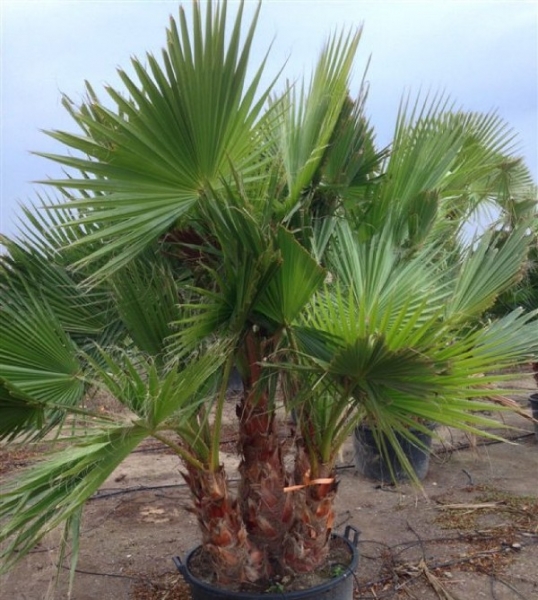
If vashingtonii the leaves began to turn brown, wither and dry out, then in the absence of decay is a natural process of development and change of foliage. In natural conditions, as we mentioned, the old leaves form a "skirt", in home conditions, they should be cleaned regularly.
Conclusion
Despite the fact that at home, the washingtonia Robusta can withstand any temperature fluctuation and humidity changes, except for heavy rains in the greenhouse-home for it requires a careful and thorough care. Despite the fact that there is evidence suggesting the ability of this palm in the open field to carry short-term drop in temperature to-18C, remember that she loses leaf plates and throughout the winter remains with a bare trunk. In the spring and let the palm will grow new deciduous cover in her usual pace, but still it is advisable to put this beauty so extreme for her tests.
The maximum that it can survive in the open ground is warm, with winter temperatures not lower than 10-15 degrees, so foreign to her climate, outdoor palm tree grown only in some areas of the black sea and Mediterranean coasts. At home with the same conditions, as already mentioned, the washingtonia Robusta is quite demanding. But eagerly responds to care for its unusual appearance, capable to decorate any interior – especially when combined with plants such as Myrtle, Laurel, oleander, dwarf pomegranate, or any citrus.
The lady’s slipper or paphyopedilum
Growing rosemary outdoors, the rules of care
